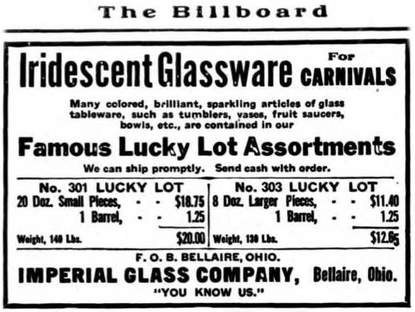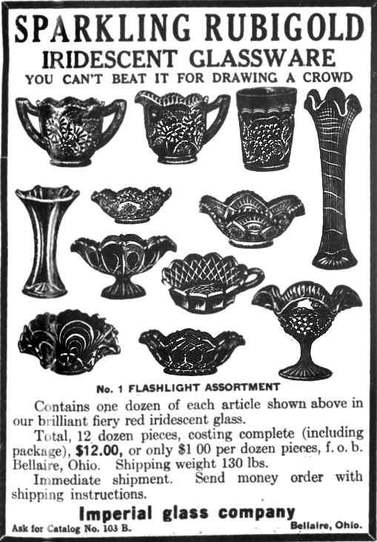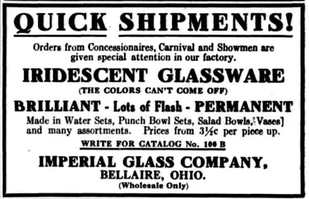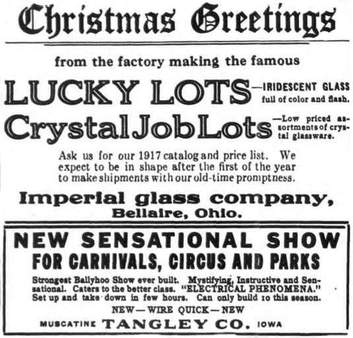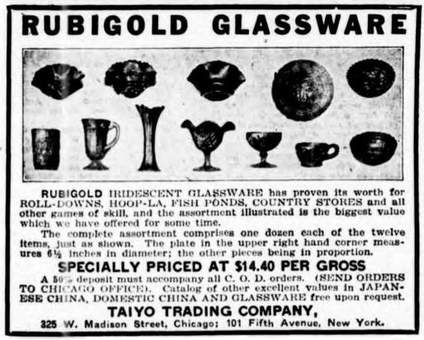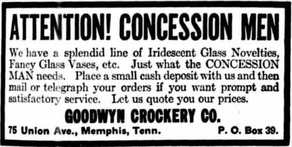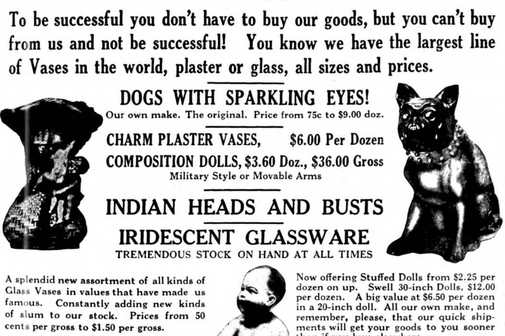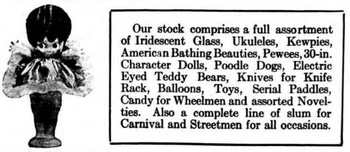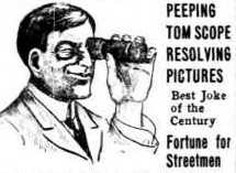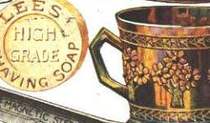The Billboard
From as early as 1915 (not the 1920s or 1930s) ads for glass as carnival prizes appeared in a popular journal called The Billboard. It was originally intended to be the trade paper for the bill posting industry, Billboard quickly widened its scope and was soon carrying ads, news and information for circuses, carnivals, amusement parks, fairs and more. In "What's in a Name?", we explore how trade publications like The Billboard helped give Carnival Glass its name.
The ad on the right below is from 1917, and the text - "you can't beat it for drawing a crowd" - links with the imagery of fairground rides, carnivals and the like, which were heavily promoted in The Billboard. Imperial were very active in using mail order, promotional and marketing techniques to sell their “Iridescent Colored Glass” to the public, and Imperial Glass featured regularly in The Billboard, often with offers for the glass to be shipped directly from Imperial's glassworks in Bellaire, Ohio.
The 1917 ad was placed directly by Imperial: note the offer at the foot of the ad to "Ask for Catalog No. 103B". This ad, like the previous ones in the Billboard, was aimed at wholesalers, and was specifically targeting the carnival and showground traders. Look at the heading: SPARKLING RUBIGOLD IRIDESCENT GLASSWARE-YOU CAN'T BEAT IT FOR DRAWING A CROWD". You can almost hear them shouting "Roll Up, Roll Up .."
The ad on the right below is from 1917, and the text - "you can't beat it for drawing a crowd" - links with the imagery of fairground rides, carnivals and the like, which were heavily promoted in The Billboard. Imperial were very active in using mail order, promotional and marketing techniques to sell their “Iridescent Colored Glass” to the public, and Imperial Glass featured regularly in The Billboard, often with offers for the glass to be shipped directly from Imperial's glassworks in Bellaire, Ohio.
The 1917 ad was placed directly by Imperial: note the offer at the foot of the ad to "Ask for Catalog No. 103B". This ad, like the previous ones in the Billboard, was aimed at wholesalers, and was specifically targeting the carnival and showground traders. Look at the heading: SPARKLING RUBIGOLD IRIDESCENT GLASSWARE-YOU CAN'T BEAT IT FOR DRAWING A CROWD". You can almost hear them shouting "Roll Up, Roll Up .."
|
The items are described as "brilliant fiery red iridescent glass". In Imperial's catalogue 103B, the information regarding this colour was noted thus:
"Crystal glass, with a deep ruby iridescence on a ground of gold. Red and gold predominate in this color, though there are tints of other colors." How many pieces can be identified in this "No. 1 Flashlight Assortment"? The Pansy creamer and sugar, the Ripple vase and Imperial Grape tumbler are easy. What about the rest? A Scroll Embossed bowl, and Imperial Grape comport and a Heavy Grape handled nappy. Is it getting trickier now? There's a Propeller comport and a Twins berry bowl; there's also a Three in One bowl and what looks like a Morning Glory vase. But what is that small bowl on the second row down on the left? It's hard to tell ... but it is Imperial's #282, aka Hobstar. |
|
Elsewhere in our unique "Sell it to me!" feature, we show how Imperial used mail order catalogues from Lee Manufacturing and from Perry G Mason, but it seems that The Billboard was a particularly favoured option for them.
The ad on the left from 1915, specifically targets "Concessionaires, Carnival and Showmen" with "special attention in our factory". The descriptions of the iridescent glass are fascinating and truly delightful to ponder. “Lots of Flash” really sums it up! But note the other selling point— “the colors can’t come off”. It’s permanent. The "Lucky Lots" ad below is from 1916 and has an interesting comment that Imperial expected to be in shape in early 1917 "to make shipments with our old-time promptness." It implies there had been problems with deliveries - maybe this was the on-going effect of the disastrous Ohio floods of 1913 which we know from contemporaneous press reports has a major impact on Imperial's operations - read about the Ohio floods here. |
|
The Billboard from 1922 (above right) conjures up wonderful images of country fairs and circuses, referring to "games of skill" for "roll downs, hoop-la and fish ponds" (and indeed such games endured well into my childhood in England in the 1950s and 1960s in amusement arcades and at fairs and seaside resorts.)
Lots of other popular products as well as Carnival Glass were offered as prizes and similar inducements at fairs and the like. This selection of ads shows the wide range of such items - from bulldogs with sparking eyes to character dolls, teddy bears and (naturally) candy ...... plus the almost inevitable joke telescope! |
|
So what we have from all the Billboard ads above was an emerging picture of iridescent glass being firmly associated with carnivals from as early as 1915, being reinforced time after time - the term Carnival Glass was slowly but surely entering the vernacular. In "What's in a name?" we explore in more detail how Carnival Glass got it's name, and the (almost 100) other names it has been called over time. Read how it might even have been called "Slum Glass" (thankfully not!) Click on the image on the left to read the story. |
